How Do I Transfer My Verizon Account to Another Phone
I run a desktop and a laptop. They both have the same email address as my husband and I share this. When the PC is switched on, the emails come into that one, but when the laptop is on, they come into that one if the PC is switched off. Is there any easy way to transfer emails from the laptop to the PC without having to set up a new email address or sending each individual email to myself?
I get variations of this question a lot.
There are a lot of misunderstandings of exactly what email is, where it lives, and what it means to have an email address. Clearing up some of that should help you understand what's happening here, and also help you decide how you want to handle it.
Where email comes from
Email comes from everywhere: from all of your correspondents and potentially from people all over the globe.
When they send you email, it is placed in a central location provided by your email service provider (ESP).
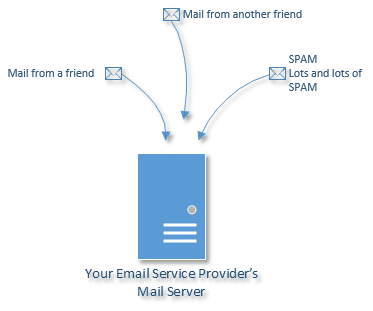
If your email address is @hotmail.com, then that mail server is run by the folks at Microsoft who own Hotmail. If you're @gmail.com, then it's Google. If your email address is provided by your ISP, then it's their server. You get the idea. Email that is destined for you is collected on a server that's run by your email provider.
When you get your email, that's where it comes from.
Where email goes
So, what happens when you read your email?
As my most common response goes, it depends.
There are three basic approaches:
- Web-based
- PC-based1 using POP3
- PC-based using IMAP
Reading email on the web
Web-based email is any email that you read using your web browser. Reading your email is really just like reading any other web page on the internet, except that you must log in to be identified. For example, to read your Gmail, you go to http://gmail.com (or http://mail.google.com). To read your Hotmail, you go to http://outlook.com. To read your Yahoo! mail, you visit http://mail.yahoo.com, and so on.
The key is that other than providing the browser that you use to access your email, your PC is not involved. Your email remains on the email provider's mail server and is not downloaded to your machine2.
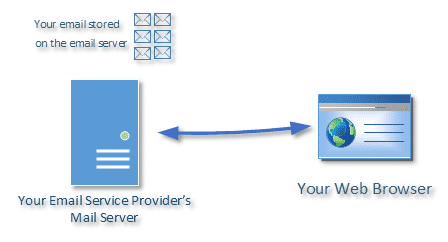
The email never leaves the server and remains stored there. Your inbox, folders, and whatever else that you choose to keep as part of your email, including perhaps even your contacts, is all kept on that server.
The convenience is that you can access it from any computer at any time as long as you can connect to the internet and log in to your account.
The downsides are that it requires an active internet connection to read your email and you're subject to the speed of that connection. Also, if you lose access to your account, you lose access to everything in it, perhaps forever in the case of most free accounts.
Reading email on your PC using POP3
With a PC email program configured to use the POP3 protocol, you actually move your email from the server to your own PC when you download your email:
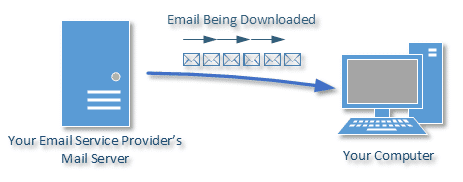
Once downloaded, the email resides only on your machine.
Because it's on your machine, you'll need to make sure that you're backing up properly so as not to lose everything should your hard disk die. You should be doing that for more than just your email anyway, so this shouldn't be an extra step.
[The benefit is that your email is on your machine and you can do with it what you will. It's typically faster to access, edit, or change, and there's no real storage limit other than the size of your own hard disk. And you don't have to be connected to the internet to read it.
The downside is that it's on your PC and only your PC. You need access to that PC to deal with it.
POP3 makes a basic assumption that you may not be continuously connected to the internet. It was designed during the days of dial-up modems where you would dial in, download your email, and then disconnect. You would read and compose email offline and then when ready, reconnect to the network to send and receive.
Reading email on your PC using IMAP
With a PC email program configured to use the IMAP protocol, email is copied from the server to your PC, leaving the original on the server:
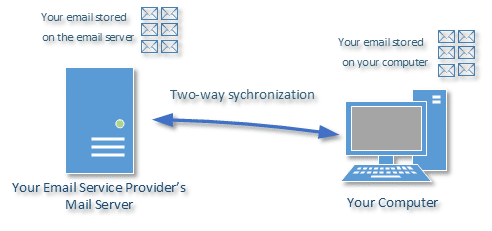
In addition, the actions that you take on your PC (like deleting a message, managing folders, and reading messages) are automatically synchronized and reflected on the server's copy of your email.
While IMAP can work relatively well with intermittent internet connections, it really makes the assumption that you have a continuous connection and works best when you do.
One email – Multiple places
So what we struggle with is how best to access the same email from more than one PC. Once again, there are three approaches:
- Web-based
- PC-based using POP3
- PC-based using IMAP
Multi-access using webmail
By far, this is the easiest approach.
Don't download your mail.
Simply, and always, leave your email on the mail server and view it using the provider's web-based access.
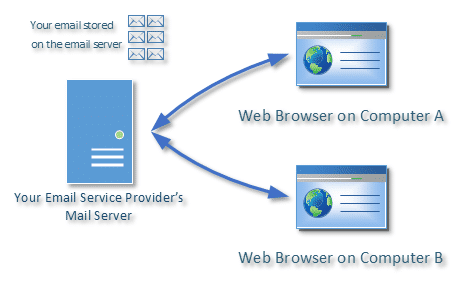
Aside from security concerns, the benefit to this approach is that it doesn't matter what computer or device you use. If it has a web browser, you can access your mail. This is a very common approach to managing email.
The biggest issue with this approach is that all of your eggs are in a single basket. If you lose access to the email service for any reason, all of your email and everything else that might be associated with it is lost.
Multi-access using PCs configured to use POP3
In the past, most computer email programs have been configured to use POP3 by default. That means that it was at least difficult (and often very confusing) to have more than one computer accessing the same email account. Messages would get downloaded to whichever PC happened to get mail first.

The confusion happens because after computer A in the example above downloads messages 1, 2, and 3, they are removed from the server. When computer B comes along, all that it sees are messages that have arrived after computer A downloaded the mail.
One solution to this problem is to instruct computer A, and possibly computer B, to not delete messages after downloading. That's typically a Leave Messages on Server setting in the advanced account configuration settings of the email account. This way, the messages are left on the server and are downloaded to both computers A and B.
Unfortunately, this exposes another annoyance. When you delete a message on computer A, it remains on computer B and on the mail server. To truly remove it, you'd want to delete it on each. That's something that you would need to do explicitly.
It can work, but it's easy for the computers – and you and I – to quickly get confused.
Multi-access using PCs configured to use IMAP
IMAP handles multiple computer access very well. In fact, it's the protocol used by many email apps on mobile devices.

Each computer that you have configured to use IMAP gets its own copy of, and view onto, your email. Delete a message on computer A? It's deleted from the server and computer B. Get new mail? It appears on the server and on computers A and B. In fact, because the email continues to live on the server as well as any IMAP-connected computer, another scenario is possible:

In addition to accessing your email via a PC-based email program, you can also access your email via a web browser, assuming your email provider has a web-based interface. It's basically the best of all worlds.
Unfortunately, there are a couple of issues that can make the transition to using IMAP a little difficult:
- As I mentioned before, IMAP more-or-less assumes a continuous internet connection to work smoothly.
- Email is actually downloaded once for each computer that you have configured to access the account. This means that more data is transferred across your internet connection, a consideration if your internet is metered or slow.
- There is typically no way to convert an existing account configured in an email program from POP3 to IMAP. The typical way to transition to IMAP is to create a new account configuration in your email program that uses IMAP and then disable the account configuration using POP3.
- If, after using IMAP for a while, you need to reinstall your email program and start over, or you add a new computer to access the email via IMAP, typically all of the email on the server will be copied down as the program synchronizes for the first time.
Keeping email on the server
There's one final issue with any of the solutions that keep all of your email on the email provider's server.
Quotas.
This varies dramatically from provider to provider, but many will allocate you only so much space in which to store all of your email. If the amount of email that you keep on the server exceeds this amount, called a quota, then the service will typically stop accepting new mail for you. Messages sent to you will usually be bounced back to the sender with some kind of "over quota" error.
Leaving all of your email on a server in "the cloud" is a very handy approach. I do it myself, but it's important to understand what limitations may be imposed by the service that you're using.
Whose email is it, anyway?
Lastly, one comment in your question leads me to this closing thought.
As we've seen, "machines" don't have email addresses. You can choose to access email from a particular machine, but that doesn't really tie it to that machine in any meaningful way other than that access.
People have email addresses.
Now, it's not that uncommon for some folks to share an email address. You may want to consider separate email addresses and share (by forwarding) only those emails that make sense to share.
Just a thought. I know my wife doesn't want to see 90% of my email and vice versa.
1: I use "PC" here to reference any device on which you read email that runs an email program. That could be a desktop or laptop computer, but it may also include a variety of portable and mobile devices as well. The key is that the device has an email program used to access your email.
2: OK, OK. Technically, when you view a web page, it is "downloaded" to your machine so you can view it. Viewing email on the web is viewing web pages. The distinction here is that it's not download as email . It's "downloaded" only as something that's being displayed in your browser's window.
How Do I Transfer My Verizon Account to Another Phone
Source: https://askleo.com/how_do_i_deal_with_one_email_account_on_two_machines/
0 Response to "How Do I Transfer My Verizon Account to Another Phone"
Post a Comment